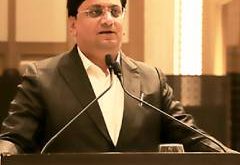Once a purely creative field manned by highly committed and dedicated professionals (much like healthcare and education), advertising has today gone the way of all industry- technology enablement has changed its face like all sectors that are in business. While most applications are common across industry, advertising is a slightly late entrant on the IT bandwagon. However, almost a decade ago, in February 2006, Kiran Gopinath founded a global advertising technology platform. It was aimed to help make programmatic ad tech easy, empowering small and mid-market brands to employ some of the most high-performing advertising technology available today.
Adadyn, earlier known as Ozone Media, recently rebranded itself as “Adadyn” to better reflect the launch of its new technology platform. It offers solutions in partnership with a number of IT service providers- fraud and malware protection agencies, DSPs and SSPs, trading desks, and more, helping smaller agencies with bigger ideas to reach their target audience at lower costs and better efficiencies.
To the industry, technology offers scalability, unlimited dynamic creativity techniques and all other advantages it offers to any other enterprise. ITVAR speaks to Kiran Gopinath Founder & CEO of Adadyn, a self-taught professional who has played a definitive role in the online media ecosystem and is recognized for his thought leadership and industry expertise being one of the pioneers of the internet advertising industry in India, as early as 1997.
1. Advertising, once a creative field is now also in the technology domain. How do you find the creativity changing due to this?
With technology making inroads into advertising, there is a huge opportunity for marketers to capture the right audience. It is critical for marketers to be able to efficiently tailor their creative and messaging to meet the exact needs of the customer. Creativity is actually more important as it needs to be more effective and should be customized across all channels- display, mobile, native, video- for clients, to truly deliver a “one-to-one” marketing experience. In order to do this, data needs to be leveraged to better understand audience intent and target the right audience with relevant content.
2. What technologies do you think will stand the test of time for marketing?
Consumers are becoming more empowered than ever to choose the content that they are exposed to. As consumers get more assertive with information that they see – the choices they make and the buying decisions are driven by multiple factors. While there is still a certain percentage of impulse buying, purchase behaviour can be altered by effective story telling. In light of this changing consumer behaviour, data adoption will be key to empowering marketers and Programmatic advertising is one such technology which relies heavily on data. It will continue to evolve and become more indispensable with time as it permeates all online channels.
3. What technology support do you offer for the marketing industry?
Adadyn is our proprietary technology platform. As part of Adadyn’s commitment to making programmatic ad tech easy, affordable and accessible for all, the platform empowers mid-market brands to quickly and affordably employ some of the most sophisticated and high-performing display advertising technology available on the market today. In terms of technology, seamless Programmatic advertising involving minimal effort is what Adadyn provides to its customers.
4. Innovation used to be the buzzword for marketing strategy. You need to be better than the next man to win, what edge do intelligent applications give you?
You can better predict the behaviour of your target audience and engage with them more meaningfully such that they become loyal customers. Innovation is still required in message creation, but using data and technology, helps make this innovation more impactful. Innovation lies in the seamless blending of Audience, Creative and Media. A platform like Adadyn helps you achieve this in a way that is accessible to all advertisers, not just the large players.
5. Social media today plays a huge role in marketing strategy. Do you think it’s a hype or are there stats to prove its efficacy?
It is indeed an important piece in opinion gathering and sensing the pulse of the market a business operates in. However, much can also be lost in translation since facts and figures require due diligence before being circulated. Everyone wants a social presence but very few leverage it well, what businesses need are insightful conversations that can even pique the interest of the uninitiated while bringing to fore key trends etc. Social media has promoted information consumption immensely, which can go a long way in helping marketers make better targeting decisions w.r.t to their audience. It is an effective programmatic marketing channel since users engage with specific content and a marketer can tailor make their messaging based on this information and show dynamic content.
6. Retail is a rapidly changing domain- a new technology to drive it very regularly. It was also one of the first to benefit from data analytics. What do you think is the biggest technology driver in this industry?
Historically,retail has seen faster technology adoption than any other vertical. The fast evolving consumer needs, exposure to social media and on-going conversations thereof, the increasingly reduced attention span of the consumer, all together contribute to the innovation of technology in this space. Awareness levels are higher now than before, the consumer is more assertive and most definitely knows what they are looking for and hence it becomes imperative for a retailer to think one step ahead of this consumer. All these salient features drive technology for Retail. The retail industry requires real time changes in advertising and customization in its offers in order to keep them relevant. Technologies like programmatic advertising are therefore essential in Retail in order to meet the marketers’ needs.
7. Advertising strategies rely heavily on Big data, do you have applications that work around that?
Yes, we have a patent pending on our decision and optimization engine. This will utilize big data and help advertisers make better targeting choices to maximize their ROI.
 Latest Technology News Today – Get Latest Information Technology Updates and Services Latest Technology News Today – Get Latest Information Technology Updates and Services
Latest Technology News Today – Get Latest Information Technology Updates and Services Latest Technology News Today – Get Latest Information Technology Updates and Services 









